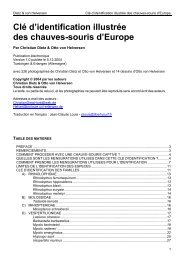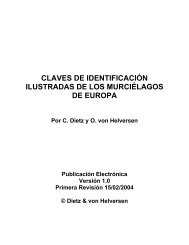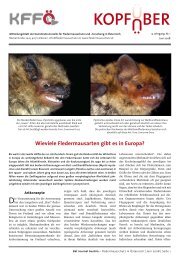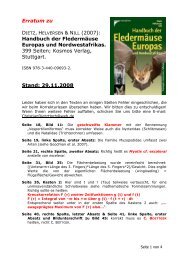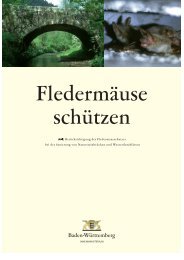Dietz & von Helversen Illustrated Identification key to the bats of ...
Dietz & von Helversen Illustrated Identification key to the bats of ...
Dietz & von Helversen Illustrated Identification key to the bats of ...
Create successful ePaper yourself
Turn your PDF publications into a flip-book with our unique Google optimized e-Paper software.
<strong>Dietz</strong> & <strong>von</strong> <strong>Helversen</strong><strong>Illustrated</strong> <strong>Identification</strong> <strong>key</strong> <strong>to</strong> <strong>the</strong> <strong>bats</strong> <strong>of</strong> Europemm (15.2 - 18.3 mm). TragL usually < 14 mm, TragW usually < 5.2 mm. Dorsalpelage brown-grey <strong>to</strong> brownish. – Plecotus kolomba<strong>to</strong>viciAdditional characters: CM 3 < 5.7 mm (> 5.7 mm in P. austriacus).Distribution in Europe: In Europe only along <strong>the</strong> Adriatic coast, many Adriatic islands andGreece.Taxonomical notes: BENDA et al. (2004) described a new form <strong>of</strong> long-eared <strong>bats</strong> fromNor<strong>the</strong>rn Africa (“gaisleri”). Due <strong>to</strong> a lack <strong>of</strong> a sympatric occurrence <strong>of</strong> <strong>the</strong> three closelyrelated forms “teneriffae” (from <strong>the</strong> Canary islands), “gaisleri” (nor<strong>the</strong>rn Africa) and“kolomba<strong>to</strong>vici” (Adriatic coast, Greece and Tur<strong>key</strong>) <strong>the</strong>y were claimed <strong>to</strong> be subspecies<strong>of</strong> one single species. As teneriffae was <strong>the</strong> species described first, <strong>the</strong>y refer <strong>to</strong> <strong>the</strong>m asPlecotus teneriffae teneriffae, P. t. gaisleri and P. t. kolomba<strong>to</strong>voci. Never<strong>the</strong>less, all threeforms might represent independent species, as two <strong>of</strong> <strong>the</strong>m (P. t. gaisleri and P. t.kolomba<strong>to</strong>vici) were found in sympatry on <strong>the</strong> island <strong>of</strong> Pantelleria. Fur<strong>the</strong>r research isneeded <strong>to</strong> solve this taxonomical problem. Characters given in <strong>the</strong> identification <strong>key</strong> aboveare only valid for <strong>the</strong> form “kolomba<strong>to</strong>vici” in Europe. P. t. gaisleri differs in having a darkercoloration <strong>of</strong> pelage and naked parts and a larger thumb and forearm (FA: 37.2 - 40.9mm). P. t. teneriffae is quite large (FA: 40.1 – 46.0 mm) and has a dark ash-grey ventralpelage coloration.Pho<strong>to</strong>graphs: 46, 48, 223 - 225 and 238 – 240.► Larger species: FA in males usually > 38 mm, in females > 39 mm (36.5 – 43.5mm). D3 > 64 mm (64 – 71 mm). D5 > 51 mm (48 – 55 mm). Tib > 18 mm. TragL:14.0-16.0 mm and TragW > 5.4 mm. Dorsal pelage grey, but in east-mediterraneanpopulations (Greece, Bulgaria, European part <strong>of</strong> Tur<strong>key</strong> sometimes brownish-grey). –Plecotus austriacusAdditional characters: CM 3 > 5.7 mm (< 5.7 mm in P. kolomba<strong>to</strong>vici).Distribution in Europe: Distributed all over central and sou<strong>the</strong>rn Europe, in <strong>the</strong> north <strong>to</strong>sou<strong>the</strong>rn Britain, missing in Denmark and Scandinavia. Everywhere in <strong>the</strong> south includingmost Mediterranean islands, but missing on <strong>the</strong> Adriatic islands.Pho<strong>to</strong>graphs: 217 – 219, 232 – 234.63



